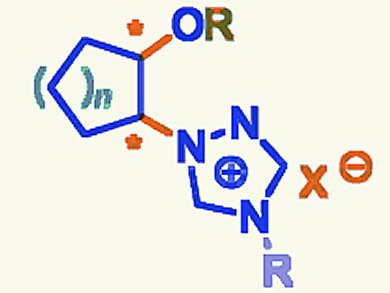The triazole nucleus is one of the most important nitrogencontaining heterocyclic compounds commonly found as a structural feature in a large family of natural products and pharmacological agents. Triazoles act in a myriad of applications as medicinal enzyme inhibitors and selectors for analytical purposes, but are mainly important scaffold cores in synthetic chemistry. The syntheses and characterization of both 1,2,3- and 1,2,4-triazoles have been extensively investigated in recent years. Although click chemistry is probably the ideal way to prepare 1,2,3-derivatives, there is a lack of general chemical routes for the access to 1,2,4-triazoles.
Dr. Vicente Gotor-Fernández, Universidad de Oviedo, Spain, and colleagues present a simple, robust, and straightforward synthetic method for the production of enantiopure 1,4-dialkyl-1,2,4-triazolium salts from commercially available 1,2,4-triazole and cycloalkene oxides.
The key step is the asymmetric acetylation of racemic trans-alcohol precursors catalyzed by Pseudomonas cepacia lipase (PSL-C I) or Candida antarctica lipase B (CAL-B). This leads to enantiopure alcohols or acetates that are ideal precursors of N-heterocyclic carbenes. In addition, cis-alcohols were satisfactorily resolved by using PSLC I, although for simplicity a chemoenzymatic approach from enantiopure trans-alcohols was used for the synthesis of the corresponding enantiopure chiral salts. In all cases, the triazolium salts have been easily obtained by clean and atom-economic reactions of nitrogen quaternization followed by anion exchange, which demonstrates the possibility to modulate the physical and chemical properties of the obtained triazolium derivatives. Finally, the Michael addition between diethyl malonate and trans-chalcone has been studied with a representative range of triazolium derivatives, and a significant chiral induction has been observed when enantiopure species were used as additives.
- Enantiopure Triazolium Salts: Chemoenzymatic Synthesis and Applications in Organocatalysis,
Nicolas Rios-Lombardia, Raffll Porcar, Eduardo Busto, Ignacio Alfonso, Jose Montejo-Bernardo, Santiago Garcia-Granda, Vicente Gotor, Santiago V. Luis, Eduardo Garcia-Verdugo, Vicente Gotor-Fernandez,
ChemCatChem 2011, 3, 1835–1840.
DOI: 10.1002/cctc.201100218




